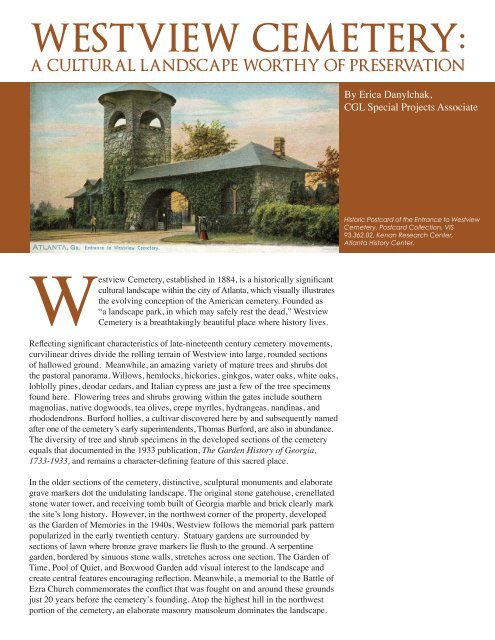ashley wright mcintyre lecture series established - Atlanta History ...
ashley wright mcintyre lecture series established - Atlanta History ...
ashley wright mcintyre lecture series established - Atlanta History ...
Create successful ePaper yourself
Turn your PDF publications into a flip-book with our unique Google optimized e-Paper software.
WESTVIEW CEMETERY:<br />
A CULTURAL LANDSCAPE WORTHY OF PRESERVATION<br />
Westview Cemetery, <strong>established</strong> in 1884, is a historically significant<br />
cultural landscape within the city of <strong>Atlanta</strong>, which visually illustrates<br />
the evolving conception of the American cemetery. Founded as<br />
“a landscape park, in which may safely rest the dead,” Westview<br />
Cemetery is a breathtakingly beautiful place where history lives.<br />
Reflecting significant characteristics of late-nineteenth century cemetery movements,<br />
curvilinear drives divide the rolling terrain of Westview into large, rounded sections<br />
of hallowed ground. Meanwhile, an amazing variety of mature trees and shrubs dot<br />
the pastoral panorama. Willows, hemlocks, hickories, ginkgos, water oaks, white oaks,<br />
loblolly pines, deodar cedars, and Italian cypress are just a few of the tree specimens<br />
found here. Flowering trees and shrubs growing within the gates include southern<br />
magnolias, native dogwoods, tea olives, crepe myrtles, hydrangeas, nandinas, and<br />
rhododendrons. Burford hollies, a cultivar discovered here by and subsequently named<br />
after one of the cemetery’s early superintendents, Thomas Burford, are also in abundance.<br />
The diversity of tree and shrub specimens in the developed sections of the cemetery<br />
equals that documented in the 1933 publication, The Garden <strong>History</strong> of Georgia,<br />
1733-1933, and remains a character-defining feature of this sacred place.<br />
In the older sections of the cemetery, distinctive, sculptural monuments and elaborate<br />
grave markers dot the undulating landscape. The original stone gatehouse, crenellated<br />
stone water tower, and receiving tomb built of Georgia marble and brick clearly mark<br />
the site’s long history. However, in the northwest corner of the property, developed<br />
as the Garden of Memories in the 1940s, Westview follows the memorial park pattern<br />
popularized in the early twentieth century. Statuary gardens are surrounded by<br />
sections of lawn where bronze grave markers lie flush to the ground. A serpentine<br />
garden, bordered by sinuous stone walls, stretches across one section. The Garden of<br />
Time, Pool of Quiet, and Boxwood Garden add visual interest to the landscape and<br />
create central features encouraging reflection. Meanwhile, a memorial to the Battle of<br />
Ezra Church commemorates the conflict that was fought on and around these grounds<br />
just 20 years before the cemetery’s founding. Atop the highest hill in the northwest<br />
portion of the cemetery, an elaborate masonry mausoleum dominates the landscape.<br />
By Erica Danylchak,<br />
CGL Special Projects Associate<br />
Historic Postcard of the Entrance to Westview<br />
Cemetery, Postcard Collection, VIS<br />
93.362.02, Kenan Research Center,<br />
<strong>Atlanta</strong> <strong>History</strong> Center.


